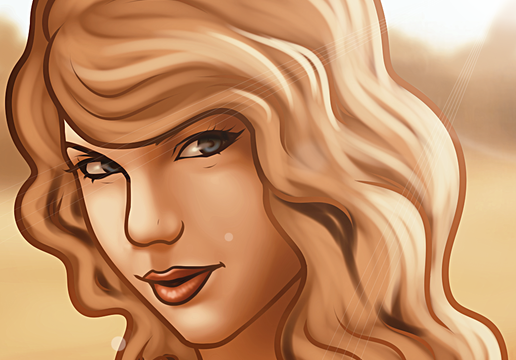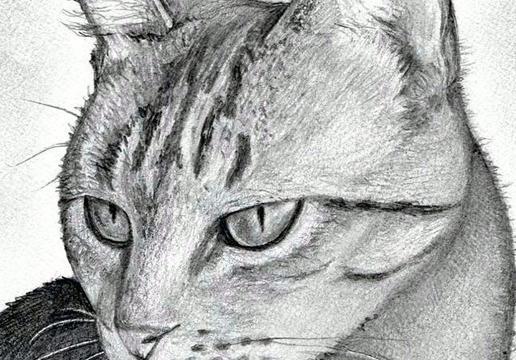How to Draw Realistic Mushrooms
1
Sketch the two curved vertical lines for the mushrooms. Lightly draw this with a No.2 or HB pencil. Make sure you draw it as seen in the picture.
3
Don't remind me... it looks like a misaligned basketball mimicking a football. *giggle* Go ahead and draw in those curved lines. They're not perfectly matching so watch closely where they "V" together.
4
You can draw in the two curved lines in the first oblong shape. Don't forget to add the half circle to the second oblong shape. The reason for these lines are for direction of pattern and easier placement.
6
I made this step separate to enable you to focus on the scale pattern. Those guidelines should help you with the curved direction of this design. You don't need to be perfect with their shape.
7
Now draw in the second mushroom's cap and stem. Make sure you get that cute curvy umbrella-like overhang of the cap and the ring around the stem.
8
We are almost done. There is a reason why those curved lines didn't seem to center. The stem included allows the gills to show off like the Ringling Bros. Circus tent. Look at the direction of the guidelines to help with placement. NOTE: I didn't dra
9
I made this line drawing especially for you if you don't want to do the pencil shading and blending part. Otherwise, let us continue to the pencil drawing part.
10
Here is the outline done with a 0.7mm mechanical pencil. Look closely and see if your lines look something like this. You can erase if certain areas like the eyes or nose don't line up. Take you kneaded eraser and dab off the shadow outlines or dark
11
This time Acrylics has won! Sandpaper, the new kid on the block has to take a back seat to my wonderful Titanium White or Opaque White Watercolors for HIGHLIGHTS! Yaaaa! Try it, you'll like it!
12
The picture that goes with this step shows two different ways to hold your pencil to acquire certain effects. OVERHAND: Holding a sharpened pencil in normal writing form with fingers in the middle or near the lead gives you great control and thin/det
13
Special Effects! How in the world do you create those scales and gills on the mushrooms? The secret is in how you hold the pencil and the type of pencil's edge, which is explained in the following step. Look at the different effects in this step. Pra
14
CUBE, BALL, CONE, & CYLINDER -- These are shapes everywhere in nature. It helps to know how to shade, add texture, etc. Recognizing these shapes, simplifies the landscape or subject you're looking at. TONE, SHADING, SHADOW, & TEXTURE -- Tone is the a
15
You can use your rubber kneaded eraser for reflective lights on the sides of the mushroom caps and stems, within the scale areas of the first mushroom, within the gills of the second mushroom and on the stems. Remember that the reflective light area
16
The picture here is a great exercise for value shading. I've got a little secret tip for you to make things easier. You can download this to your desktop. First click on the picture to have access to full size. By right clicking on your mouse, you ca
17
After printing out a number of the above template, practice shading in the values like this picture. You become familiar with this shading technique that gives you more control and confidence.
18
*TIP: Before I forget, I want to say this. For more realism and smooth transitional between the shadowed planes and highlights, I lighten the outlines so they'll be hardly visible. Now On with this step. This is the first start with the pastel applic
19
Here I used my blending stump to "draw" in more scale shapes and gills. I also added more shading to the caps and stems. I worked in circular motions on the side of my blending stump (underhand). I followed the lined gills with my blending stump's ti
20
I sketched in more shading on the scales, gills and stems with my 9B graphite and 0.7mm mechanical pencils. I defined the shadowed chevron-like edges of the scales. The sketching was done in circular and diagonal lines, staying close to the reference
21
I did this pencil blending separate so you can see the difference after the application. I used, of course, my blending stump. I was able to carry the graphite to smooth out lighter areas to appear darker. Graphite lines and smudges are not as recogn
22
Whoa! I covered my background with my 9B Graphite Crayon, which is so smooth. Then I purposely added reflective lights on the back of their caps and stems to make the mushrooms pop! (***TIP: When applying those white highlights, sometimes they blend
23
Without highlights, your picture would have a flat appearance. Click on this picture to learn how to make your own picture POP out!
Comments 0
Details
July 17, 2012
Description: If this weren't a mushroom, it would be a Victorian lamp! I enjoyed drawing these cute fungi and I hope you do too. Here's some Wikipedia Notes about this mushroom: "The height is 5 to 15 centimeters. The color of the mushroom is white to cream. The cap is convex to shield shaped, is arched over with a raised center, 6 to 10 centimeters in diameter, has a brownish center, and has ochre yellow to pale brown scales. The gills are white to cream." I'm not going to ramble on about the animal kingdom terms ... Wikipedia tends to do that. I hope you learn something from this tut and please enjoy! A fav, love it or comment would be fantastic! Luv n hugs to you all and thank you!!!















































